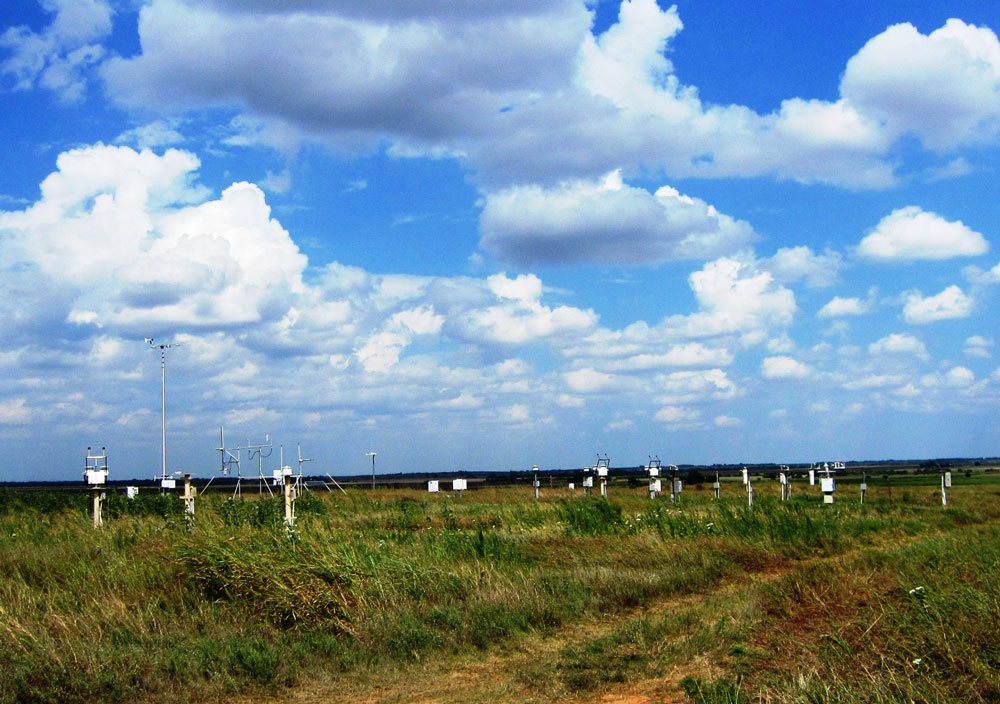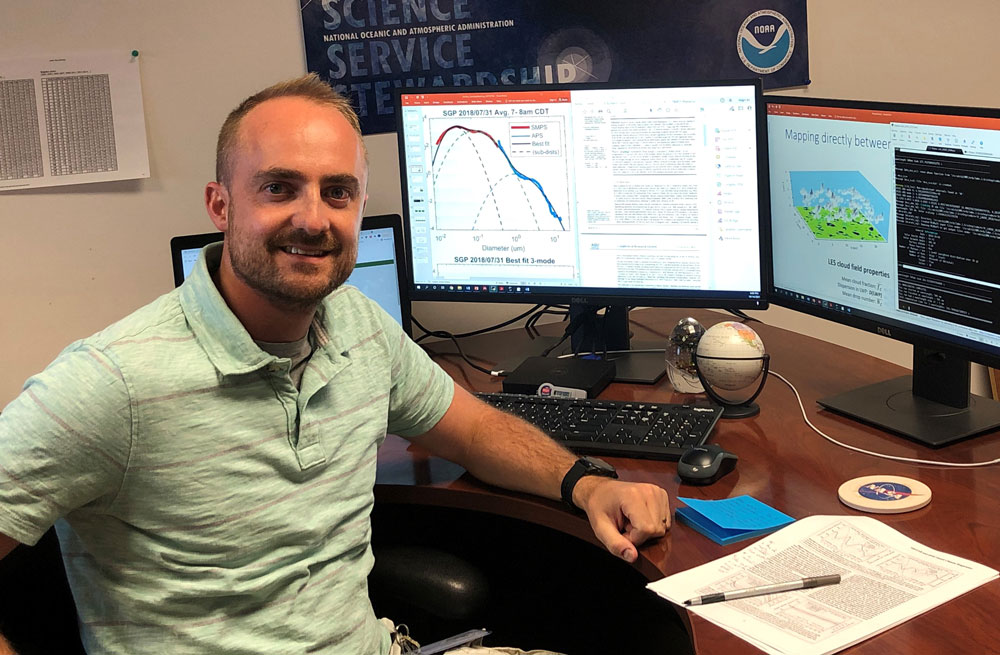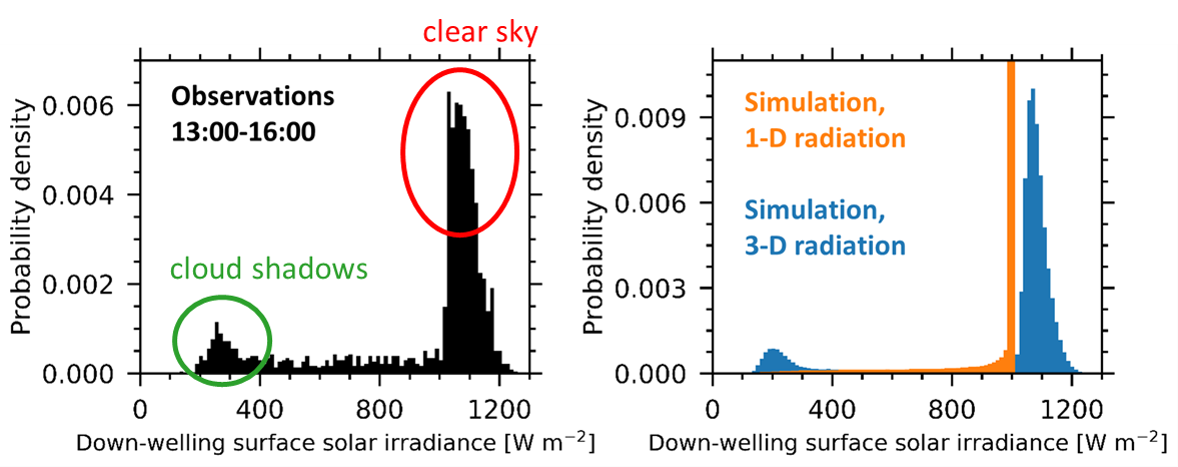LASSO Case Study: The Complex Travel of Solar Irradiance Through Cumulus Clouds
Published: 22 November 2021
A pair of studies point to improved realism in calculating solar radiative transfer in model simulations

Of all the energy the sun radiates into space, only about one-billionth reaches the Earth. But that still adds up to a staggering 173,000 terawatts (trillions of watts) a year, enough to power humankind’s energy needs about 10,000 times over.
Estimating how much solar energy reaches the Earth’s surface in a particular location is obviously important for the solar power industry. In addition, these flows of radiative energy drive the atmospheric circulations we call weather.
At the same time, solar irradiance plays a key role in the equilibrium of the whole Earth-atmosphere system, the phenomenon we call climate.
“Surface solar irradiance” is a measure of how much energy from the sun reaches the planetary surface. Like multiple shades casting speckled shadows on the ground, clouds create a complex variability as solar energy spottily hits the surface. Researchers who want to understand and model solar surface irradiance are challenged by mathematically representing clouds because they inhabit the sky in such broken fragments.
When broken clouds stand between sunlight and the Earth’s surface, it is not easy to calculate how much solar energy reaches the surface in the shadows of the clouds or the gaps between clouds. Yet when present, clouds are the primary way surface solar irradiance is modulated.
A pair of papers published in 2020 (and presented at the American Geophysical Union annual conference that year) may soon improve and accelerate such calculations. If so, that has important implications for weather and climate modelers, as well as for solar power forecasters in the renewable energy industry.
Looping In LASSO

The two studies are led by Jake Gristey, a NOAA research scientist at the Cooperative Institute for Research in Environmental Sciences (CIRES) at the University of Colorado, Boulder. A doctoral graduate of the University of Reading in the United Kingdom, he is an expert in using observations and models to study how energy moves into, out of, and within the Earth-atmosphere system.
In Boulder, Gristey is part of NOAA’s Atmospheric Science for Renewable Energy (ASRE) program, which tracks wind and solar resources. He is also involved in the Libera project―a planned NASA satellite mission that will investigate the Earth’s energy budget, including how solar energy flows at the top of the atmosphere.
Data for the papers came from the Southern Great Plains (SGP) atmospheric observatory, a heavily instrumented site spanning parts of Oklahoma and Kansas. Encompassing thousands of square miles, it’s the oldest and largest fixed site operated by the Atmospheric Radiation Measurement (ARM) user facility, funded by the U.S. Department of Energy (DOE).
Both papers—supported by DOE’s Atmospheric System Research (ASR)—rely on case studies from the LES ARM Symbiotic Simulation and Observation (LASSO) activity. (LES stands for large-eddy simulations, a common modeling technique.)
LASSO provides data bundles that combine ARM shallow cumuli observations with LES modeling of selected days to speed access to data and context for modelers. (Officially, in early 2021, LASSO shifted its processing efforts to deep convective storm systems. But nearly 100 shallow cumuli cases are in place based on SGP data from 2015 to 2019.)
“LASSO highly streamlined our project. That’s an awful lot of work―to dig into the data and to identify (the best) shallow cumulus days. With LASSO, we had these cases right up front.”
Jake Gristey, NOAA
“LASSO highly streamlined our project,” says Gristey. “That’s an awful lot of work―to dig into the data and to identify (the best) shallow cumulus days. With LASSO, we had these cases right up front.”
Gristey says that the second paper especially depends on LASSO case studies, “fair-weather cumulus cases that start and end the day with clear skies and reach cloud fractions of less than 40% or 50% in the afternoon.” (Cloud fraction is the fraction of sky covered by clouds.)
Calculating Surface Solar Irradiance
Gristey and his co-authors focused their back-to-back studies on shallow cumulus clouds. These clouds are among the biggest challenges to simulate in weather prediction models because they are small, scattered, and short-lived.
Understanding how such clouds influence surface solar-energy resources is also part of Gristey’s ASRE work at NOAA.
Shallow cumuli commonly populate land and ocean cloud regimes. Because they are so prevalent across the globe, understanding how they affect surface solar radiation is important for predicting future climate states.

The first paper, published in March 2020 in the Journal of the Atmospheric Sciences, highlights the problem, in part by using LASSO data bundles for observations and LES simulations. There is a big difference between radiative transfer calculations derived from two common sources: observations reproduced by offline three-dimensional (3D) calculations and one-dimensional (1D) calculations derived from LES.
The 1D approach to calculating solar surface radiation is routinely done in weather and climate models. This so-called plane-parallel independent column approximation approach posits a vertical column rising through the atmosphere and notes changes in properties.
“Essentially,” explains Gristey, “radiation calculations are performed for each column of the model separately by extending the column properties infinitely in the horizontal. In the real world, we do not have these (conditions).”
Closer to the real world, but expensive and slow to compute, is the 3D approach to calculating surface solar irradiance. It accounts for both the vertical and horizontal components of the atmosphere. Along with observations and LES, 3D radiative transfer calculations―also part of Gristey’s ASRE research―help dispel errors in weather prediction models and solar energy forecasts.
The 3D calculations showed systematic 1D radiative biases across several test days that ranged from 2 to 8 watts per square meter (W m–2) when averaged in space and time. The paper also showed that the local, instantaneous gap between 1D and 3D calculations could balloon to 150 W m–2 in a single afternoon. Clearly, a fix is in order.
As a start, the findings from this paper helped define observational requirements that would reduce biases in calculating surface radiative energy.
At the same time, says Gristey, the study also “quantified the importance of 3D radiative effects in shallow cumulus.”
Machine Learning Steps In

The second paper, published in October 2020 in Geophysical Research Letters, acknowledges the problem of the complex 3D structure of shallow cumulus clouds and the complex variability of the surface solar irradiance beneath those clouds.
The paper explains what can be done about it, says Gristey. “It provides a (way) to account for 3D radiative effects without the computational expense of 3D radiative transfer calculations.”
Here’s how the authors accomplished that:
With the help of the LASSO case studies, they used LES to simulate cloud fields, then employed their 3D radiative transfer calculations. From there, the authors estimated a key metric called probability density function (PDF).
“That shows how often different amounts of solar radiation reach the surface,” says Gristey of PDF when displayed on a graph. “On the horizontal axis is the amount of radiation. The (vertical axis) represents how frequently that amount of radiation occurs.”
Out of all this, Gristey (who taught himself some artificial intelligence basics) crafted two algorithms. Together, they improve the realism of 1D radiative transfer calculations and bypass computationally expensive 3D radiative calculations.
The two-algorithm machine-learning approach uses cloud sizes, cloud fractions, and other cloud field properties to predict the PDF of surface solar irradiance.
“We can (improve the realism of simulated surface solar irradiance) very well with the machine-learning framework.”
Gristey
His random forest algorithm is based on an ensemble of decision trees, which are then taught to infer the best random outcome among many. His artificial neural network algorithm mimics the rapid choices that brain synaptic networks make while turning nerve impulses into images.
“We can (improve the realism of simulated surface solar irradiance) very well with the machine-learning framework,” says Gristey, who after the first paper decided that machine learning “seemed like the ideal candidate” for making such complex inferences.
And next?
Gristey has a paper underway that adds even more complexity to the surface solar irradiance challenge. He will use machine learning and SGP data to calculate the radiative influences of atmospheric particles as they teem and coalesce between clouds.
Keep up with the Atmospheric Observer
Updates on ARM news, events, and opportunities delivered to your inbox
ARM User Profile
ARM welcomes users from all institutions and nations. A free ARM user account is needed to access ARM data.


















